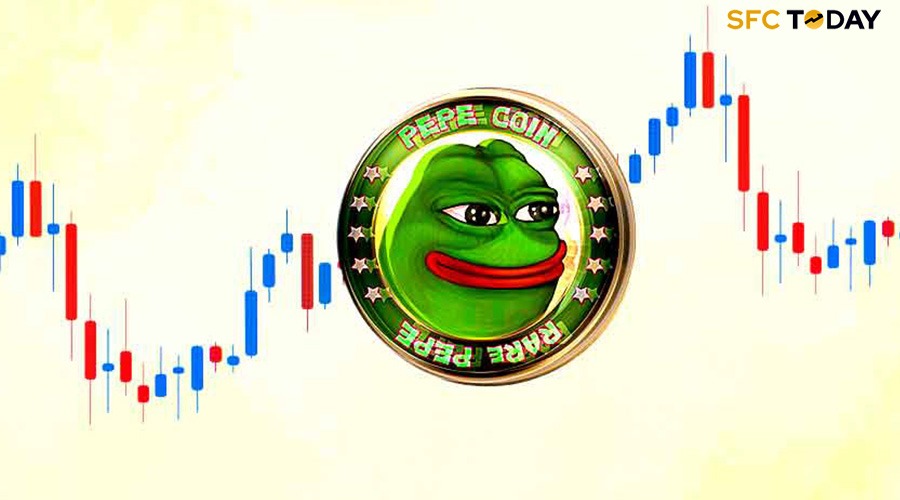Pepe (PEPE), the Ethereum-based memecoin, recently marked a significant milestone by achieving a new all-time high of $0.00001422, showcasing a notable 27% surge over the past 24 hours. After hitting an all-time high yesterday, Pepe’s (PEPE) bullish momentum faltered, sending the price to an intra-day low of $0.00001256, where support was established.
PEPE/USD 24-hour price chart (source: CoinMarketCap)
Speculations around the potential approval of spot Ether ETFs in the United States primarily drive this uptrend. PEPE’s current trading volume and market sentiment suggest a robust engagement from traders, influenced by the optimistic market conditions surrounding Ethereum and its related assets.
Analyst traders like Kaleo pointed out that the movement in ETH prices and the concurrent rise in PEPE exemplifies a classic hindsight trade opportunity. The open interest (OI) in PEPE, a metric indicating the total value of outstanding futures contracts, has escalated by 40% to $172.96 million within the same period, signaling strong trader confidence in sustaining future positions.million within the same period,
Funny how $ETH is moving and $PEPE is now one of the most obvious hindsight trades out there. https://t.co/0NQsK5IK1b
— K A L E O (@CryptoKaleo) May 21, 2024
Comparative Performance: PEPE vs. DOGE and SHIB
PEPE has displayed an impressive performance with a 990% growth since the beginning of the year, outstripping other major players in the memecoin sector, such as Dogecoin (DOGE) and Shiba Inu (SHIB).
In the past three months alone, PEPE has consistently outperformed these cryptocurrencies, suggesting a shift in investor preference towards mid-range memecoins which offer higher volatility and potential returns.
This shift is highlighted by PEPE’s substantial market cap growth to over $5.5 billion, narrowing the gap significantly with DOGE’s $25 billion and SHIB’s $15 billion. Such dynamics indicate a potentially changing landscape in the memecoin market where newer entrants like PEPE can challenge the dominance of established coins by capitalizing on timely market movements and trader sentiments.
Institutional Interest and Market Predictions
The involvement of institutional players such as BlockTower Capital has further validated the growing interest in PEPE. BlockTower Capital’s recent transaction, transferring $2.8 million worth of 202 billion PEPE to Cumberland, signifies a strategic play within the institutional framework, aiming to leverage PEPE’s market movements for substantial returns. This move coincided with PEPE’s price peak, and the firm secured a profit of approximately $578,000 over six days.
BlockTower Capital transferred 202B $PEPE($2.8M) to #Cumberland for sale 2 hours ago after the $PEPE price broke through $0.000014.
BlockTower Capital bought the 202B $PEPE($2.22M) via #Cumberland 6 days ago.
Making $578K in 6 days, with an ROI of 26%.https://t.co/bSxQ2JVkZJ… pic.twitter.com/zyntQBRmre
— Lookonchain (@lookonchain) May 22, 2024
The market outlook for PEPE remains bullish, with analysts setting a near-term target of $0.000020. This prediction is supported by the strong trading momentum and the general market sentiment buoyed by the potential regulatory approval of Ether ETFs. Should the approval materialize, an influx of fresh institutional capital is expected, potentially propelling PEPE’s price toward the forecasted target.
Potential Risks and Strategic Moves
Despite the optimistic projections, the volatility inherent in the memecoin market poses substantial risks. Traders and investors might face significant price fluctuations, which could lead to rapid gains or losses. The concept of Fear of Missing Out (FOMO) has been pivotal in driving retail investment, with a notable transaction where a crypto whale purchased over 592 billion Pepe units valued at around $8 million.
Such large-scale purchases underscore the speculative nature of the market, which, while profitable for some, may lead to considerable risks for others.
Moreover, the market is observing a trend where early investors are beginning to offload significant amounts of PEPE onto secondary markets, potentially increasing selling pressure. Such activities need to be monitored as they could lead to abrupt price corrections if the broader market sentiment shifts or if the anticipated ETF approvals face delays or denials.







